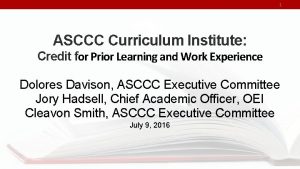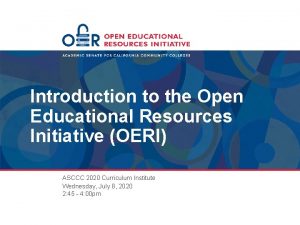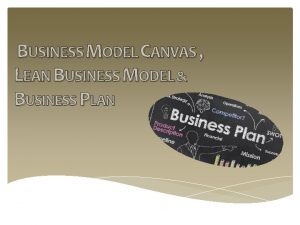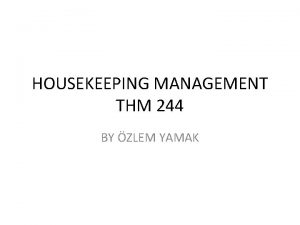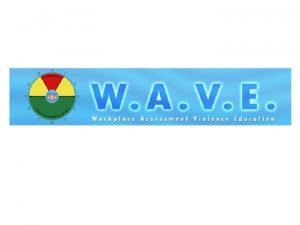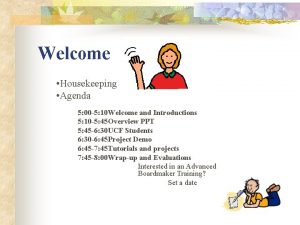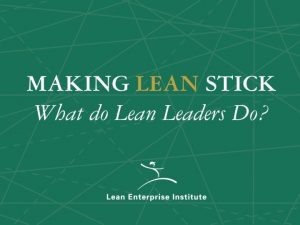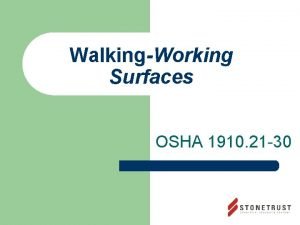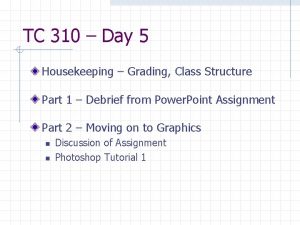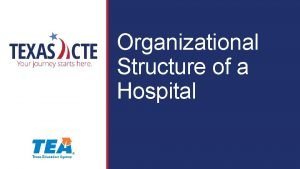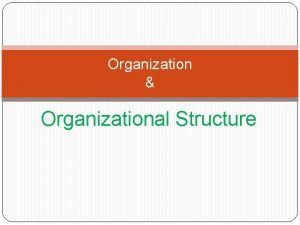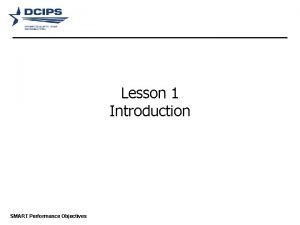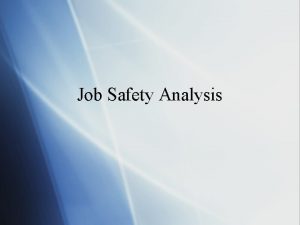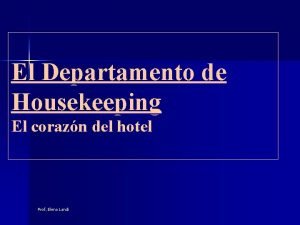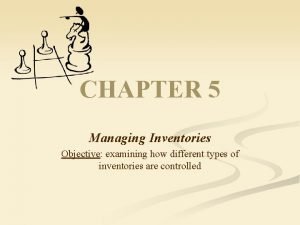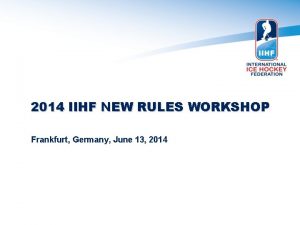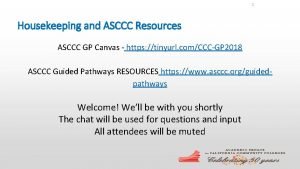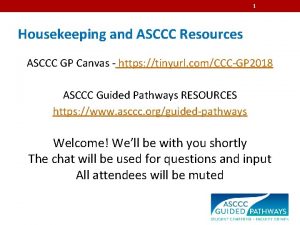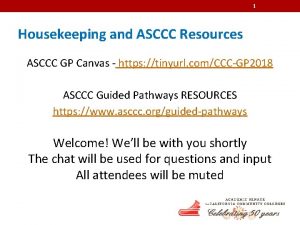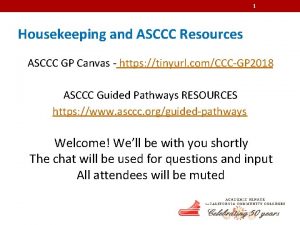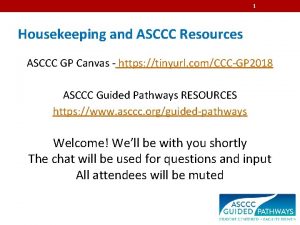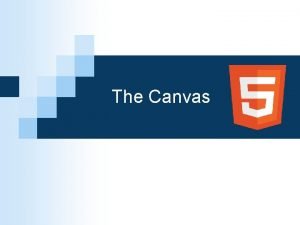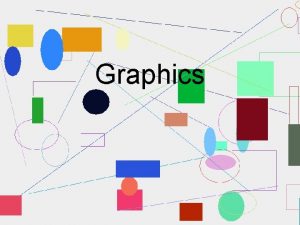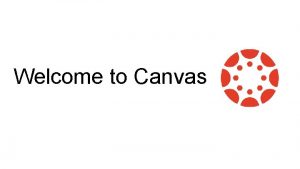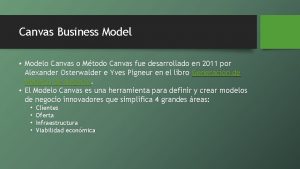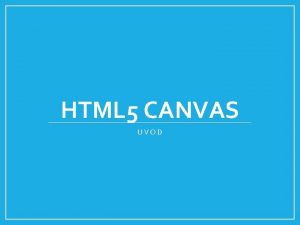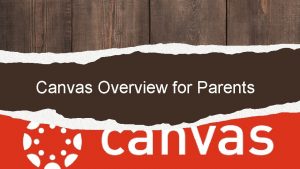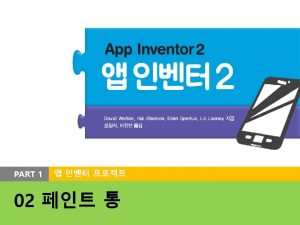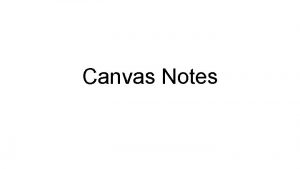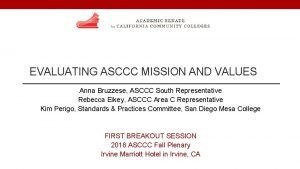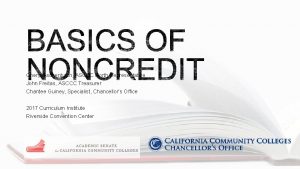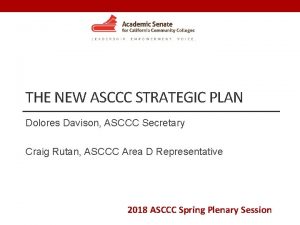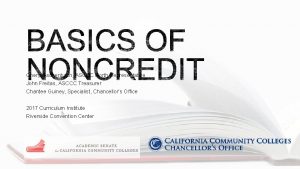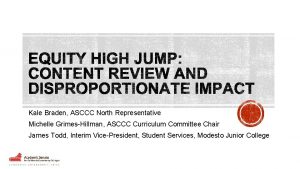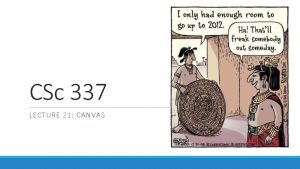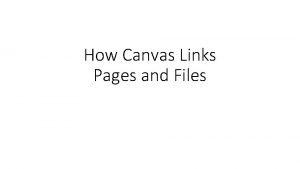1 Housekeeping and ASCCC Resources ASCCC GP Canvas





























- Slides: 29

1 Housekeeping and ASCCC Resources ASCCC GP Canvas - https: //tinyurl. com/CCC-GP 2018 ASCCC Guided Pathways RESOURCES https: //www. asccc. org/guided-pathways Welcome! We’ll be with you shortly The chat will be used for questions and input All attendees will be muted

2 Orienting Faculty to Teaching in a Guided Pathways Institution Presenters: Randy Beach, ASCCC Guided Pathways Lead, Southwestern College Jeffrey Hernandez, Academic Senate President and Professor of Political Science, East Los Angeles College Janet Fulks, ASCCC Guided Pathways Lead, Capacity Building Ty Simpson, San Bernardino Valley College, Guided Pathways Task Force

3 NEXT WEEK: Partnering with High Schools: Secrets and Good Practices We only have students for 2 years; reaching out to our high school partners is important to scaffold the concepts and decision making that provide students with the agency and autonomy they need to be successful in the time we have them. This webinar covers a variety of linkages from Summer Bridge to dual enrollment to early counseling interventions. Join us as we reveal secrets colleges have uncovered to increase success. 5/15/2019 Noon – 1: 00 PM

4 THIS WEEK: Orienting Faculty to Teaching in a Guided Pathways Institution How do we teach differently in a Guided Pathways world? If Guided Pathways redesign is about equity-mindedness and meeting students where they are at, what does that mean for individual classroom considerations and content? While GP requires institutional changes, implementation within the classroom is key. Join us to find examples of the innovative and effective use of classrooms in helping students be successful. 5/8/2019 Noon – 1: 00 PM

5 Pillar Four: Ensuring Learning

6 Ensuring that Learning is Happening* Program-specific learning outcomes Project-based, collaborative learning Applied learning experiences Inescapable student engagement Faculty-led improvement of teaching practices • Systems/procedures for the college and students to track learning outcomes • Intentional development of critical thinking skills • • • *Santa Monica College: “Guided Pathways Framework: Four Pillars” http: //www. smc. edu/ACG/Academic. Senate/Pages/Guided-Pathways-Four. Pillars. aspx

7 Course and Program-Level Assessment • Checking data at the Course Level • Course student learning outcomes • Student surveys • Working with collaborating across faculty groups to support students • Student education plans in the classroom • Assessing learning at the program level • Program learning outcomes • Program review • Institutional student learning outcomes

8 Faculty Roles Are Changing

9 Discipline Faculty Experts • The primary role of the Discipline Faculty Expert is to share their discipline area and student pathway expertise with students. Discipline faculty experts will: • • • Act as a resource for students by becoming experts in the coursework and broader pathway requirements for certificates, degrees, and employment in their pathway; Explore and stay current on the transfer and career options for their pathway; Collaborate with high school outreach efforts; Support programs to ensure student progression and connect students to relevant support services; Review and promote thoughtful scheduling of courses based on student progression; Report systemic issues to the completion team (and its administrator).

10 Counselors and Advisors • The primary role of Counselors and Ed Advisors is to become experts on the coursework, internships and employment associated with the pathway. Counselors will: • • Counsel students in educational planning and transfer decisions Recommend effective course placement; Develop and conduct co-curricular activities, workshops, forums, etc. relevant to Affinity Group or pathway areas in collaboration with career center, job placement specialists, transfer center, etc. ; Work with students flagged as needing intervention (i. e. probation, SOC, early alert, etc. ).

11 Academic Development & Support Faculty • The primary role of the Academic Development (ACDV) faculty expert is to support students through the remediation and academic development component of their pathway. ACDV faculty coaches will: • • • Guide and support students through their applicable remedial courses and course sequences; Connect individual students to appropriate support services; Provide workshops and coursework addressing academic development and study skills; Demonstrate knowledge of pathway courses and the broader pathway program requirements; Design and coordinate support services, such as Extend the Classroom, for pathway courses.

12 Instruction, Faculty and GP Alignment • Cross Disciplinary • Program Minded not course or discipline minded • More connected to Work and transfer • • Reminder of no direct transfer (Biology to Biology or Sociology to Sociology or English to English) Relook at Degrees with a Guarantee Contextualized coursework, e. g. , assessment prompts linked to transfer/career • Know the curriculum value of what you teach • IGETC, CSU Breadth, Degree Applicable • Consider introductions to the program with options for students • Re-evaluate course SLOs in light of program (transfer and career) outcomes

13 Tips from Guided Pathways Teaching Faculty Workshop* In project-based learning, where the instructor is a “Guide on the Side” vs. “A Sage On the Stage. ” • • Students work in teams or individually throughout the semester to produce a project that is the culmination of everything they have learned. Project-based learning teaches students critical thinking, time management, teamwork and contextualizes the class material for them. Another aspect of teaching differently is to be intrusive, to contact students when they miss more than one class or do poorly on an exam. Set a tone for the course with a syllabus centered on the students learning experience, building more flexibility. * Source: Nora Zepeda, Guided Pathways Teaching Faculty Workshop Series, East Los Angeles College

14 Classroom Faculty as Institutional Agents* • The Guided Pathways mindset involves rethinking institutional systems and practices with the student experience in mind. • This mindset should help non-traditional students who often find it difficult navigating institutional resources to support their learning. ● Classroom faculty can use their knowledge and position to transmit institutional opportunities, privileges, and services to students who are experiencing social marginalization. * Source: Presentation by USC Center for Urban Education at ELAC Academic Senate Retreat, November 30, 2018

15 Classroom Faculty as Institutional Agents* Classroom faculty can… • assess their student’s needs, • identify resources to address these needs, • facilitate access to these institutional resources, • and help ensure their students utilizes resources * Source: Presentation by USC Center for Urban Education at ELAC Academic Senate Retreat, November 30, 2018

16 What changes have you seen in instruction at the course level because of your guided pathways work? Please place your responses in the chat

17 A Mind at Work: Maximizing the Relationship Between Mindset and Student Success • New findings indicate that community college student success is related to productive mindsets. 2019 CCSSE National Report https: //www. ccsse. org/NR 2019/Mindset. pdf • Components of an Academic Mindset • Growth vs fixed mindset • Self-efficacy • Relevance of academic experience • Sense of belonging

18 Components of Academic Mindset https: //www. ccsse. org/NR 2019/Mindset. pdf

19 Growth Mindset & Self. Efficacy related to GPA Define Growth mindset & Selfefficacy https: //www. ccsse. org/NR 2019/Mindset. pdf

20 Institutional Planning / Administration • Consider whether the institution will create gateway and/or capstone courses. • The institution should determine the effect of courses or classes that have high failure and withdrawal rates. • Design professional development for various employees regarding helping students develop more productive mindsets. • Evaluate where students report learning about a growth mindset, particularly with regard to test-taking and math. • Create training and opportunities for employees to specifically address mindset and self-efficacy.

21 Counseling and Learning Support • Mindset can be incorporated into orientation, student success courses, gateway courses. • Consideration should be providing professional development for advisors so they can help students develop more productive mindsets. • Encourage people staffing learning labs to talk to students about how to have a growth mindset, particularly with regard to test-taking and math. • Having a productive academic mindset is correlated with use of academic advising. https: //www. ccsse. org/NR 2019/Mindset. pdf

22 What changes have you seen in counseling and learning support practices because of your guided pathways work? ? ? Please place your responses in the chat

23 Instruction • Ask students about their career goals and how they might see connections with their current coursework? • Integrate career and transfer goals into course assignments. • Talk to students about success and failure, how it applies to education and life pursuits. • Provide regular and meaningful feedback to students about their performance and progress, specifically calling skills consistent with career goals. • Help students navigate support and resources on campus by identifying specific supports related to the course.

24 Instruction and Developing Self-Efficacy • Faculty members should provide examples of what strong work looks like and what it entails versus just doing the work. • Course expectations should be clearly communicated. • Consider how to build confidence that students can learn anything. • Create professional development to help students address their fears of failure with new and intimidating content.

25 Student Agency and Empowerment • Student agency refers to learning through activities that are • • • meaningful and relevant to learners, driven by their interests, and often self-initiated with appropriate guidance from teachers. • Student agency gives students voice and often, choice, in how they learn.

26 Strategies for Creating Relevance for Students • • • Connecting to careers Connecting to transfer Connecting general education Field Trips Guest Speakers Cooperative Work Experience

27 Questions and Comments

28 Additional Resources • ASCCC GP Canvas - https: //tinyurl. com/CCC-GP 2018 • ASCCC Guided Pathways RESOURCES https: //www. asccc. org/guided-pathways • A Mind at Work: Maximizing the Relationship Between Mindset and Student Success https: //www. ccsse. org/NR 2019/Mindset. pdf • Santa Monica College: “Guided Pathways Framework: Four Pillars” http: //www. smc. edu/ACG/Academic. Senate/Pages/Guided -Pathways-Four-Pillars. aspx

29 NEXT WEEK: Partnering with High Schools: Secrets and Good Practices We only have students for 2 years; reaching out to our high school partners is important to scaffold the concepts and decision making that provide students with the agency and autonomy they need to be successful in the time we have them. This webinar covers a variety of linkages from Summer Bridge to dual enrollment to early counseling interventions. Join us as we reveal secrets colleges have uncovered to increase success. 5/15/2019 Noon – 1: 00 PM
 Asccc leadership institute
Asccc leadership institute Asccc curriculum institute
Asccc curriculum institute Asccc oeri
Asccc oeri Lean model canvas vs business model canvas
Lean model canvas vs business model canvas Transformed and transforming resources
Transformed and transforming resources Fixed resources definition
Fixed resources definition Canvas partners
Canvas partners Renewable resources vs nonrenewable resources
Renewable resources vs nonrenewable resources Housekeeping productivity formula
Housekeeping productivity formula Welcome and housekeeping
Welcome and housekeeping Housekeeping meeting agenda
Housekeeping meeting agenda Housekeeping webinar
Housekeeping webinar Osha housekeeping standard 1910
Osha housekeeping standard 1910 Housekeeping feladata
Housekeeping feladata Types of housekeeping
Types of housekeeping Monthly wife
Monthly wife Housekeeping monthly 1955
Housekeeping monthly 1955 Debriefing in housekeeping
Debriefing in housekeeping Guest request in housekeeping
Guest request in housekeeping Ddo housekeeping
Ddo housekeeping Housekeeping slide for presentation
Housekeeping slide for presentation Hospital organizational structure
Hospital organizational structure Organization structure of hospital pharmacy
Organization structure of hospital pharmacy Smart goals for housekeeping
Smart goals for housekeeping Job safety analysis housekeeping
Job safety analysis housekeeping Organigrama del area de housekeeping
Organigrama del area de housekeeping Magazynier bielizny
Magazynier bielizny Opl in housekeeping
Opl in housekeeping Non recycled inventories in housekeeping
Non recycled inventories in housekeeping Workshop housekeeping rules
Workshop housekeeping rules

